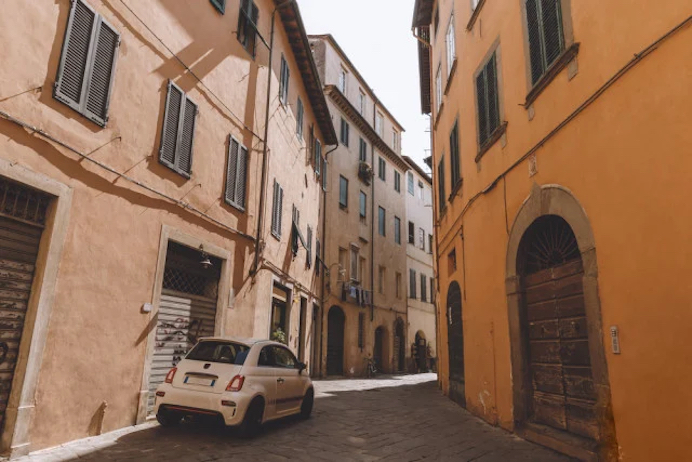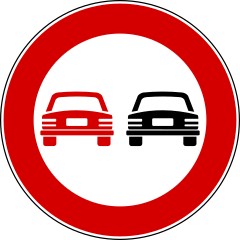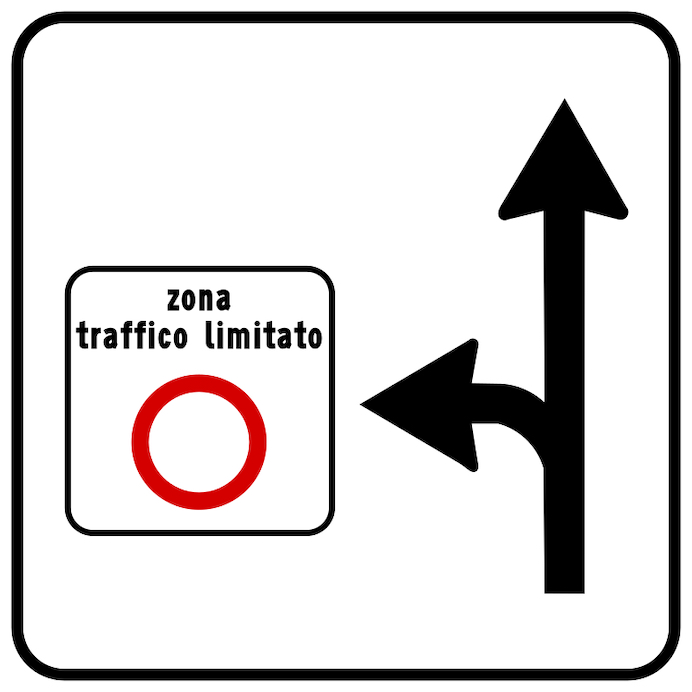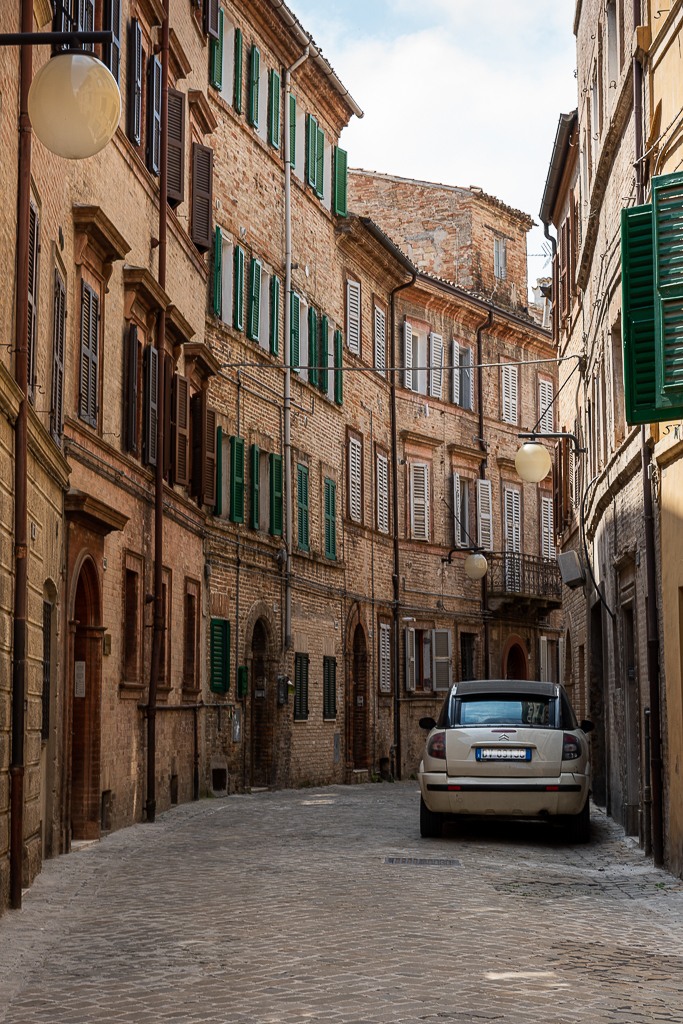
Italy’s most popular tourist destinations are easily reached by plane, train, or cruise ship. But to see Italy’s hidden treasures, to travel like a local, to experience first-hand Italy’s dolce vita, rent a car and drive to smaller cities and tiny villages.
Driving in Italy is a sport. Italians drive fast, except when they drive slow. They tailgate, then slam on the brakes at a “zebra crossing.” They use both hands to speak while driving, and they drive in-between designated lanes, as if to create additional ones.
And yet, my trips to Italy were more immersive and enchanting once I got behind the wheel. It will for you too. Here is everything you need to know to drive in Italy.

Before you Drive
You’ve taken pictures of your rental car and are ready to leave the lot. Before you do, turn on your headlights. Low-beam and parking lights are required at all times in suburban areas and the motorways.
Buckle your seatbelts, even passengers in the back seat — it’s the law. Children under the age of four must be in an approved safety seat and children aged four to 12 are required to use a booster seat until they reach 1.5 meters tall (about 4.9 feet). Your car rental company can provide both.
Program your destination into Waze, or a similar GPS system that displays the speed limit, and alerts you when you’re exceeding it. Speed limits change often, even on the same road, and are not always marked. If you’re American, you may want to change your GPS settings to metric so they match the road signs.
Mobile phone use is allowed only in “hands-free” mode.
Leave your International Driving Permit in the vehicle. It won’t do you any good in your luggage in your hotel room. You also need your driver’s license.
If it’s between November 1 – April 30, depending on where you are driving, you may be required to have snow chains in your car, or winter tires mounted.

Speeding
As a general rule, the speed limit on major freeways, (Autostrada, some Strada Statale) is 130 km/h (80 mph), reduced to 110 km/h (68 mph) in rain or bad weather. On divided highways in suburban areas (Strada Statale), the limit is 110, or 90 (56 mph) in inclement weather. On secondary and local roads (Strada Provinciale) the speed limit is 90 km/h, reduced to 80 km/h (50 mph) when raining. In cities it is 50 km/h (31 mph) regardless of weather.
Speed limits are enforced by a vast network of cameras, which are marked but easy to miss, especially when you don’t speak the language, you’re trying not to get lost, and you’ve got one eye on your rearview mirror. Waze is good at warning when you approach a camera, but be advised some locations change weekly.
To add to the confusion, two different systems monitor speed. One is clearly marked “controllo elettronico della velocità con sistema tutor.” Usually on the Autostrade (plural for Autostrada), the Tutor system uses two cameras at fixed points to establish an average speed. If your average speed is over the limit, expect a ticket to arrive by mail. The second method, signaled by “controllo elettronico della velocità” is simply a camera with a radar, either in a box along the road or hand-held by a police officer.
As with the Tutor system, don’t expect to be pulled over and fined for speeding. You’ll get a ticket in the mail. If you really want to prepare, the Polizia di Stato website publishes camera locations, updated weekly. (In Italian, but you can use Chrome or an extension to easily translate.) Many small towns also have speed cameras that should be designated, but even at a slower speed, they are easily overlooked.
As stated on my speeding ticket, drivers are given a 5% tolerance over the posted limit, with a minimum of 5 kmh for a speed limit of 100 kmh or less. Anything above that speed is subject to fees that start at € 41 and can reach € 336. Fines increase incrementally with higher speed violations, and if it occurs in the evening, a surcharge is added.
Your first indication that you have a ticket is if a charge appears on the credit card that you used to pay for your rental car. You might even receive an email from the car rental agency advising you that you have received a ticket and they have charged you an administrative fee to provide your information to the local authorities.
The ticket itself may take months to arrive. The police have 360 days to notify you. My ticket arrived by registered mail almost 4 months later. My fine, for driving 4 kmh over the threshold in a 70 kph zone, was € 44.60 including “notification and procedure costs” if paid within 5 days of the receipt of the notification, which they know because they sent it certified mail. Hertz also charged me € 25 for the aforementioned administrative fee, lower than the € 50 that Europcar charged me for a “ZTL” infraction.
My ticket arrived the same day as my husband’s, although his was from a different region and 4 months before mine. Both were in English and provided websites to view our crimes captured on camera. They offered methods to appeal but none were convenient for a guilty foreigner. The only way to pay was by international wire transfer, for which many American banks charge exorbitantly.
I don’t know what happens if you don’t pay. Our tickets stated that after 60 days, “relevant tax authorities will be entitled to recover the half of the maximum amount of the violation” — more than double the fine. We drive often in Italy, so for us non-payment was never a question.

Italian Driving Quirks
Especially when driving on the Autostrada, you might think speed limits are not enforced in Italy, or that the drivers flying past you have some sort of immunity. Whether on the 8-lane Autostrada or a 2-lane country road, you’ll look in the rearview mirror that you just peeked at 3 seconds ago and suddenly a car has appeared out of nowhere, the driver is tailgating you, flashing their headlights, and gesticulating wildly. What we consider criminal tailgating is Italian habit. Don’t take it personally.
Stay in the middle or right lane on the freeways. Use the left-most lane only to pass and be quick about it. Signal your intent, but don’t expect other drivers to do so. Constantly check your mirrors, especially when changing lanes. Don’t try to understand why some drivers leave their turn signals on. I’ve asked several Italians and they don’t know either. If the driver behind you on a freeway flashes their lights, move to the right. Signs above the Autostrada display blue circles and speed limits by lane. Those are the minimum speeds you can drive in each lane.
Lane dividing lines are painted but don’t be surprised to see cars straddle them and drive in-between lanes, especially the left and middle ones.
Entrance and exit ramps are shorter on Italian highways so accelerate quickly to merge with traffic. Italians are fairly polite about moving over to accommodate incoming cars. The next exit is painted on the pavement in the right lane in addition to roadside signs.
Emergency stop areas are marked and often include a telephone. In the event of a breakdown or problem, wear the fluorescent safety vest usually found in the trunk of your rental car and place the warning triangle 50 meters from your car. In the unlikely event that you cannot reach your car rental agency, roadside assistance is available from the Automobile Club of Italy 24/7 by calling 800.116.800 from a foreign mobile phone.

Autogrills
Autogrill is the most common rest stop in Italy. I’ve had a light lunch in a couple of them and have left thinking that I could have eaten better for less money elsewhere. If you’re hungry and it’s lunch or dinner hours, exit the freeway, consult Google Maps, and find a local restaurant nearby. We stumbled upon a family owned bar and restaurant on the road from Rome to our house in the Marche. They source their own meats and breads locally and our lunch there was less expensive than Autogrill.
If it’s outside serving hours, Autogrill’s sandwiches are not bad. Ask them to heat it for you (caldo means warm). I’ve never had their cafeteria-style hot food. If you see several police cars or a lot of semi trucks parked at a rest stop, that’s a good sign. They know where to find a good meal on the go.
Drinking and Driving
Italy’s blood alcohol limit is 0.5 gr/l, or 0.05%, lower than many states in the U.S. If you are found above that, the penalties are severe. You can be fined € 527 to € 6,000, banned for driving, prosecuted, and imprisoned up to one year. Police routinely perform random security and sobriety checks. And not always at night. My husband Matt was driving from a wine tasting on a weekend afternoon when a police officer stepped into the road holding a stop sign. He approached our car and asked to see his license. Matt handed it to him, along with his International Driving Permit, which I think was the first one the police officer had ever seen by the curiosity with which he regarded it. The officer shook his head at his boss sitting in the car and waved us on. Thankfully, Matt had not been drinking, but don’t assume you won’t get stopped in broad daylight.

Tolls
Most autostrade have tolls. At the first stop, you’ll get your ticket (biglietto). Do not pick the Telepass lane. As you exit the autostrada, you’ll have to pay. Again, do NOT take the Telepass lane. Pick a lane that shows a credit card symbol to pay by credit card (American cards accepted), or the money symbol to pay in cash. Insert your ticket, the machine will tell you what you owe, and gives change. If an agent is available, the sign will display a hand giving change. You can estimate the tolls for your route on the Autostrada website.
Roundabouts
I found roundabouts pretty fun once I got the hang of them and it’s an easy way to turn around when I get lost. In a one-lane roundabout, you enter to the right when it’s clear and signal only when you get to your exit. In a multiple-lane roundabout, if you’re taking the first exit, you must use the right lane to enter and signal right. If you’re going straight, use the right lane to enter, and signal only when you approaching your exit. If you need to go left, enter the roundabout from the left lane and signal left, then move to the right lane, and signal right. That sounds more complicated than it is, and it becomes intuitive.

Passing
On two-lane country roads you might get stuck behind a tractor or a slow driver. You can pass on the left if it is not a “no passing zone” indicated by solid double white lines, and/or with a sign that has a red car to the left of a black one. That being said, ensure you check for oncoming traffic with the understanding that an approaching car can appear seemingly out of nowhere. Likewise, if a driver wants to pass you, move to the right a bit. I recommend familiarizing yourself with Italian road signs before you get there and bringing a printed version for quick reference.
Strade Bianche – White Roads
Are so called because they are typically white gravel. They might be paved or dirt, but in all cases, they are narrow. Commonly found in the idyllic countryside, these roads are not heavily trafficked or maintained. If you meet another car, the one going up a hill has priority. You may have to reverse to find space to allow them through. Take your time, relax, tranquillo. Italians driving in the countryside are generally very accommodating.

“Zona Traffico Limitato” The Dreaded ZTL
More than forty Italian cities have restricted traffic zones (ZTL), usually around the “centro storico” city center. In ZTLs vehicular traffic is restricted to residents, or authorized at certain times of the day, or a congestion charge is required to access. Research the areas where you plan to drive in advance and in Rome, look for signs that say “Varco Attivo” meaning the ZTL is active and you cannot enter. “Varco non Attivo” means you can drive freely. A sign that says “Zona Traffico Limitato” with a white circle and a red border is another sign not to cross, unless the hours posted below it indicate otherwise. In Milan’s center is an “Area C” for which you can buy a pass online and activate upon your arrival in Milan. In some smaller towns, your host or hotel may be able to register your car with the police to allow admittance.
As with speeding, ZTLs are enforced by a surprisingly efficient camera system, and if you violate one, you will be fined both by the authorities and the rental car agency.
Road Signs
Stop signs are red and say stop, so that’s easy. If you see a red circle with a white horizontal rectangle it means wrong way, do not enter. A narrow, white arrow on blue indicates one-way traffic, is often faded, and shockingly small. You may see the words “senso unico” which mean one way. A quick hint to determine if you are about to go the wrong way down a one-way is to look for parking signs on the street. If you can’t see any, you may be making a mistake.
I’ll cover parking signs in the next article of this series but “no parking” is represented by a red-framed blue circle with a red line through it. Just remember, parking signs are blue and things you can’t do are red.
You’ll see “Varco Aperto” on signs on the highways. It just means there’s a short stretch of road ahead where the center divider is missing.
Galleria means a tunnel, and they are marked with an odd sign that is clearly intended to represent a tunnel but when flying past it at 130 kmh, it doesn’t look like anything.

Crosswalks and other town hazards
At zebra crossings, or crosswalks with black and white striped lines, you are legally required to stop to allow a pedestrian to cross, usually screeching to a halt to do so. As a pedestrian though, do not assume the driver is paying attention and cross only when you know it’s safe.
There is no right turn on red in Italy. A red light means you can’t go anywhere.
An Italian would want to avoid traffic and drive their car in the bus lane but it’s a fineable offense. Thankfully, when I accidentally drove in the bus lane the only witnesses were curious bystanders.
In villages with narrow lanes, you may want to fold in your side mirrors when negotiating tight spaces.
Don’t blindly obey your GPS instructions. The app does not know it’s market day and the road is closed. If, like me, you find yourself driving through a crowded market in Sicily, smile and shrug in a rueful apology. You won’t be the first.
Getting Gas
Diesel cars are common in Italy. Double check your rental’s fuel type before filling it with gas. “Benzina senza piombo” is unleaded gasoline and diesel or “gasolio” is diesel. Getting gas in Italy can be an adventure, and one you’ll pay a lot for. We recently paid € 1.73 per liter for diesel, or about € 6.65 per gallon.
Especially in rural areas, it may be hard to find a gas station open 24/7 and some close for lunch. Many gas stations offer full service, so if your rental car lacks washer fluid (it happens often to me) and you need your windows washed, pick full service. They sometimes give you a free coffee too.
To pump your own gas, look for “Fai da te” which means do it yourself. You may have to pre-pay at an outdoor kiosk by entering your pump number and credit card or cash. Some gas stations let you pay inside the store afterwards, or to an attendant outside with a credit card reader, or my favorite, a drive-through booth with an attendant. Some gas stations even have disposable gloves you can use. In large cities, micro gas stations are tucked along the streets.

The Cinque Terre and Amalfi Coast
I have been to both but have never driven them. In the Cinque Terre, the villages do not allow cars, so you pay to park outside the town, then walk (typically uphill). The narrow roads are hairpins and may induce carsickness. A train connects the villages from the La Spezia station, I recommend that or the ferryboats instead.
The Amalfi Coast is breathtakingly beautiful and the driver will miss it all because their eyes will be on the road. The passengers may get carsick, and if you drive there in the summer, you’ll spend a lot of vacation time in horrendous traffic and looking for a parking spot. The roads are narrow for two-way traffic and overridden with tour buses you can’t see coming around the curve. Unless you’re driving in the off-season, I recommend taking the public bus, hiring a driver for a day trip, or better yet, ride a ferryboat.
Sicily
An Italian friend of mine thought his wife had not understood my Italian when she told him that I had driven in Sicilia. He later asked me, wide-eyed with incredulity, if the rumor was true.
Even some mainland Italians confess a fear of driving in Sicily. But if I can do it, so can you. That being said, do not drive in Palermo or Catania. Many Sicilians have cautioned me against doing so, and I heed local advice.
The rest of Sicily is drivable, with caveats. In my experience, GPS is not as accurate, so expect to get lost. In some areas, the roads are potholed, missing shoulders, and without dividing lines. A Sicilian driver behind me blared his horn when I dared to stop at a stop sign. Another driver honked his displeasure when, at the end of a road, I stopped to look, then waited for oncoming cars to clear before I proceeded. During a morning traffic jam in Trapani, we all drove around two stopped cars while the drivers conversed in the busy intersection.
Sicily is one of my favorite places in the world. Sicilians are warm-hearted, and if you get lost they will help you.
In my next articles I’ll cover everything you need to know to park in Italy.
If you think I’ve missed something or if you have any questions please leave a comment.
Buon viaggio!
Useful Links:
Everything you need to know about renting a car in Italy
Polizia di Stato information on camera speed enforcement (Italian, use Chrome or an extension to translate)
PDF of Road Signs in English to Bring With
Rome’s ZTL information in English
Autoeurope has a guidebook in English for driving in Italy
The Automobile Club of Italia is an excellent resource for advice in several languages
The Hertz guide to driving in Italy
Wikipedia’s Road Signs in Italy Page
Useful vocabulary:
Mi sono perso (for a man), mi sono persa (for a woman) – I am lost
Mi può aiutare – Can you help me?
Limite di velocità – speed limit
Rallentare – slow down
Autonoleggio – car rental
Destra – right
Sinistra – left
Sempre diritto – straight ahead
Strada – street
Uscita – exit
Entrata– entrance
Rotonda – roundabout
Semaforo – stoplight
Nebbia – fog (You’ll see this on signs that advise a lower speed limit in case of nebbia)
Autostrada – the high speed toll freeway, named A + the number, signs are green
Strada Statale – highway, named SS + the number, signs are blue
Strada Provinciale – Provincial roads, named SP + the number, signs are blue
Biglietto – ticket
Telepass – A toll pass that your rental most likely does not have. Do not take this lane
Controllo elettronico della velocità con sistema tutor – Average speed zone checked by camera.
Controllo elettronico della velocità – Speed checked by camera
Patente – driver’s license
ZTL, Zona Traffico Limitato – Limited Traffic Zone – vehicular traffic may be restricted.
Varco Attivo – ZTL is active. If you pass, you may get fined.
Varco Non Attivo – ZTL is NOT active and you are free to drive past the sign.
Senso Unico – one way street
Varco aperto – road divider missing up ahead.
Galleria – tunnel
Benzina senza piombo – Unleaded gasoline
Gasolio – diesel
Pieno – full (as in tank of gas)
Fai da Te – do it yourself, self-service gas pump
Divieto – Prohibited
Vietato – Forbidden
Macchina – car
Lavori in corso – road work, men at work
Incidente – accident
Deviazione – detour
parcheggio – parking




